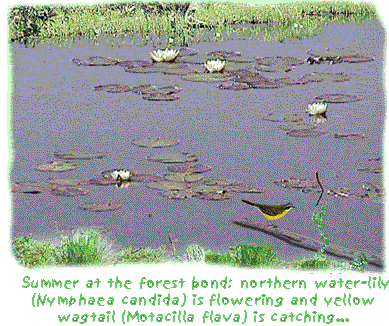

Summer time
(the end)
The actual assimilation period of numerous plants is clearly shorter in the north than in the south. This is visible in the picture below: the downy birch is in full leaf for 2-3 months in Lapland whereas in southern parts of Finland it is in full leaf for four months. The period of autumnal colours is at its best in Lapland round the middle of September. In southern Finland, this does not happen until in the end of September and in the beginning of October. In Lapland, birch as well as other plants, have to get prepared for the winter as well as the future growing period in clearly a shorter period of time than in the south. Apparently, this has multiple effects on the distribution and ecology of the plant in question (compare with the great birch destruction of Lapland!). Moreover, the frosts of the early summer may restrict the occurrence of plants in Lapland.
On the other hand, one should remember that the well-lighted midsummer nights in the north allow the plants to work for a long period time – with some plants the assimilation continues all through the night during midsummer. With some other species of plants, the assimilation comes almost to a stop for midsummer (including lichen due to dryness).
More phenological information of Metla: http://www.metla.fi/metinfo/fenologia/index-en.htm
Gathering of nutrient and energy supplies for winter, and particularly for the following spring, will begin as soon as the assimilation produces “free” resources (new growth and flowering reserve large amount of resources!). Apparently, plants in Lapland gather new supplies in their sprouts both above the ground and on the ground already in the early July… At the same time, they build their flower and growing buds for the following summer.
The summer of several big mammals starts for real when a new generation is born. Bear has given birth in midwinter, though, and wolverine in March-April. But April, May and June are the most active months for the birth of new generations. During those months, elk and reindeer fawns as well as the cubs of wolf, arctic fox, fox, lynx, stoat, pine marten, otter and squirrel are born. Hares, moles, lemmings and mice multiply very easily: they give birth to new offspring several times during the summer.
When it comes to birds, golden eagle starts laying eggs in April-May. At the same time - late winter – many owls, Siberian jay and raven lay their eggs. Because the nights, in particular, may be very cold during this time of year, the mother starts brooding as soon as the first eggs have been laid. Thus, there can be both eggs and younglings in the nest at the same time. At the end of July, bird song quietens down; the parents have tough time in feeding their growing offspring.
Only the willow warbler (Phylloscopus trochilus) might continue its singing in minor key till autumn. August is the time for younglings to learn how to fly. After that, migrants will head for the south. Some species leave very early: curlew (Numenius arquata) starts migrating in July at the latest. The first ones to head for the south are females; most of the males and young ones do not migrate until July-August. Also the crane migrates early in a similar way.
The summer time ends now!